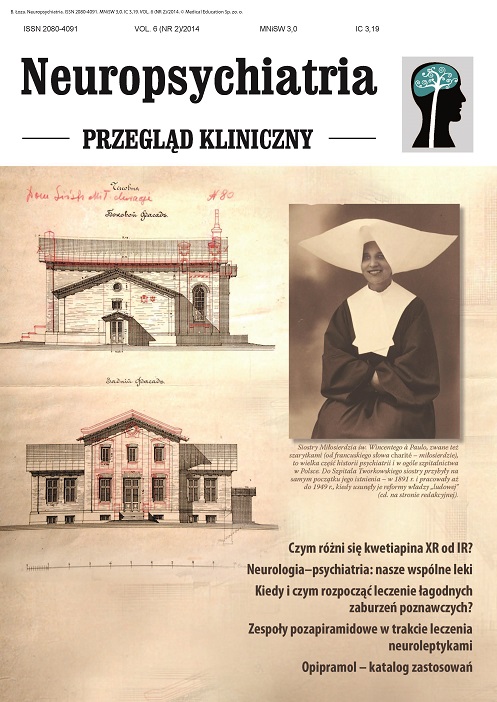16 reasons why opipramol is worthy to prescribe Review article
Main Article Content
Abstract
Opipramol is drug beyond classification. It was originally designed as analog of imipramine. Opipramol is tricyclic dibenzodiazepine derivative with side chain characteristic for perphenazine and fluphenazine. This construction places opipramol between antidepressants, neuroleptics and anxiolytics. In clinical practise it is mainly used for anxiety treatment, sleep disorders and as „mood brightener”. All that properties led opipramol to be used in psychogenic disorders, especially in somatoform disorders. Reasons for prescribing opipramol in clinical practise are listed below.
Article Details

This work is licensed under a Creative Commons Attribution-NonCommercial-NoDerivatives 4.0 International License.
Copyright: © Medical Education sp. z o.o. License allowing third parties to copy and redistribute the material in any medium or format and to remix, transform, and build upon the material, provided the original work is properly cited and states its license.
Address reprint requests to: Medical Education, Marcin Kuźma (marcin.kuzma@mededu.pl)
References
2. Muller WE, Moller HJ. Opipramol – lek przeciwlękowy i rozjaśniający nastrój (przekład red. Prusiński A). Via Medica, Gdańsk 2003.
3. Holoubek G, Muller WE. Specyfic modulation of sigma binding sites by the anxiolytic drug opipramol. J Neural Transm 2003 Oct; 110 (10): 1169-79.
4. Moller HJ, Volz HP, Reimann I et al. Opipramol for the treatment of generalized anxiety disorder: a placebo controlled trial including an alprazolam – treated group. J Clin Psychopharm 2001; 21: 59-65.
5. Agencja Oceny Technologii Medycznych. Dokumenty rejestracyjne opipramolu.
6. Prusiński A. Opipramol (Pramolan): renesans leku i jego aktualne zastosowanie. Praktyka Medyczna 2003; 46-52.
7. Benca RM, Obermeyer WH, Thisted RA, Gillin JC. Sleep and psychiatric disorders: a meta-analysis. Arch Gen Psych 1992; 46: 651-670.
8. Barbour JA. Psychotropic agent in the climacteric. Practitioner 1972; 209: 369.
9. Prusiński A. Migrena transformowana. Migrena 2000; 1: 9-12.
10. Heuppe M, Hartge D, Stoll KD, Ros A, Schmucker P, Gerlach K. Opipramol improves subjective quality of sleep the night prior to surgery: Confirmatory testing of a double-blind, randomized clinical trial. Neuropsychobiology, 2011 May 14; 64(1): 24-31.

